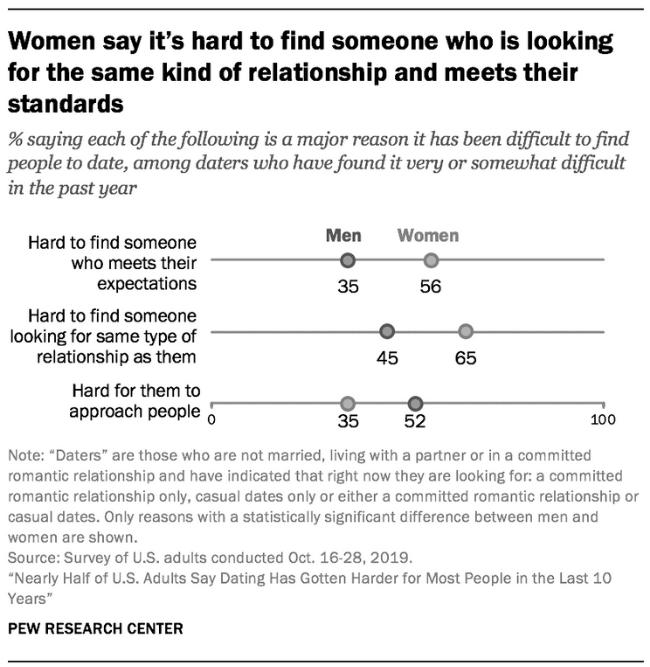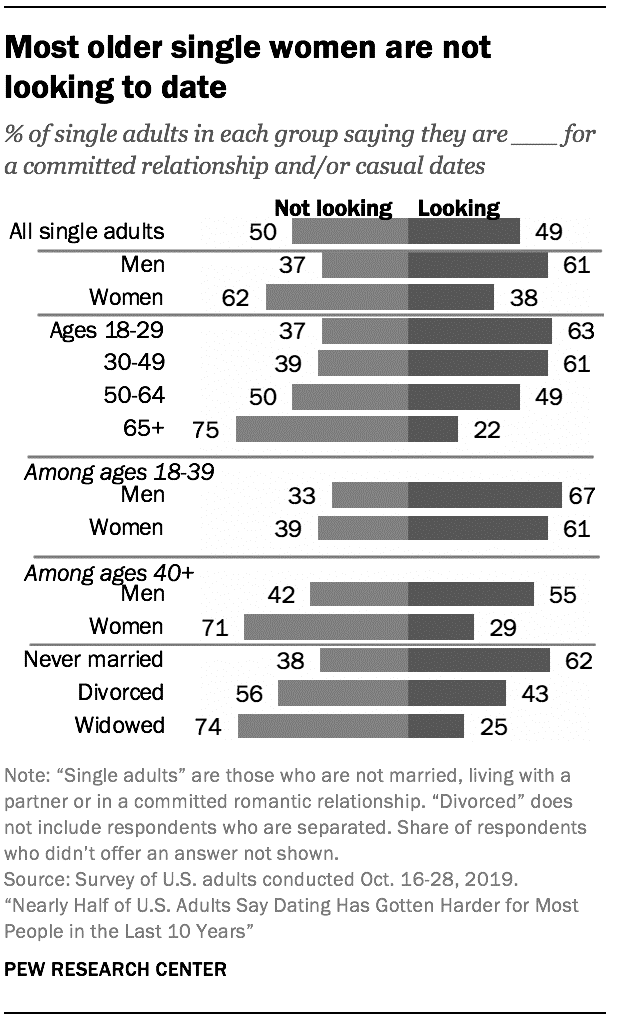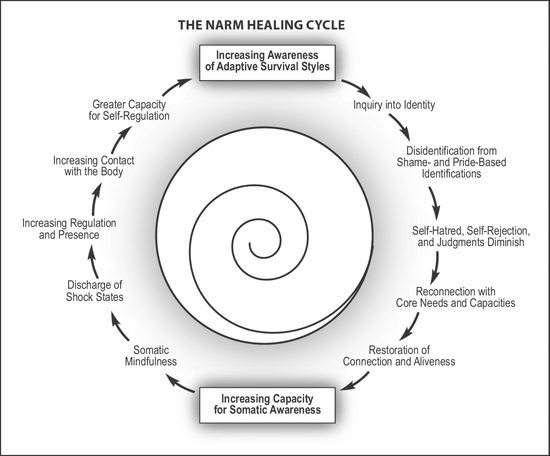Ideas move from mind to mind, but I don’t know that these ideas are always selected with reference to what helps the listeners leave the most offspring in the next generation.
~ Holmes Rolston III ~
A better system will not automatically ensure a better life. In fact, the opposite is true: only by creating a better life can a better system be developed.
~ Václav Havel ~
Despite all the proven personal benefits of being in a healthy, committed love relationship and the importance of nuclear families for thriving communities and societies, increasing numbers of people in modern and postmodern societies feel that developing the relationship skills necessary to share their lives with their soul mates and, if possible, raise children is not worth the effort.
For the first time since data was collected in 1976, there are now more unmarried than married people in the United States. This trend of fewer marriages and more divorces is worldwide. Some New Agers, spiritual practitioners, and radical feminists even view the desire to be in a romantic relationship as pathological, spiritually unevolved, or a modern form of enslavement. While being in a romantic relationship and becoming a parent must be an individual choice, it’s important to raise awareness of the negative mental, psychological, and economic consequences for most singles, as well as the larger social, environmental, and political consequences that ultimately affect everyone, and to promote the development of healthy relationship skills.
From https://ourworldindata.org/marriages-and-divorces

From the book The All-or-Nothing Marriage: How the Best Marriages Work.
Time–money–sex
The three primary reasons why some people still want to be in a love relationship are, in the widest sense, time, money, and sex.
Time
We are social animals who crave and need human contact and physical exchange for our well-being. When deprived of this, our bodies feel stress and don’t function optimally. Dopamine levels, which are essential for thinking and planning, drop, and elevated levels of norepinephrine shut down immune functions and inhibit genes that reduce inflammation.[1] It is important for couples to agree how to spend quality time together.
Money
Despite numerous age-old aphorisms insisting that money (alone) does not make us happy, recent research shows that people with higher income levels are more satisfied with life than people who are poor.[ii] Therefore, money (marrying up/sharing resources, etc.) is a natural sexual attractor and reason to be in a relationship. It is important for couples to share the same values and needs regarding money, as it is the number one cause of relationship conflict, not to mention the devastating fights over money during and after divorce.
Sex
We are sexual beings (otherwise we would not be here) and derive pleasure and many health benefits from having a healthy sex life.[iii] Couples often report being happier with their sex lives than singles. Therefore, it is important to be in a relationship and for couples to share the same needs when it comes to their sexuality.
The three big reasons why people break up are … see above!
Ten additonal reasons why relationships matter
Below are ten ego-transcending reasons why healthy love relationships are important not only for our own well-being and development, but also for the well-being of others, society, and humanity.
1. They matter to our soulmate
There is overwhelming evidence that, in addition to exercise and a healthy diet, people who live their biological purpose in happy, healthy, long-term relationships enjoy greater physical health, emotional stability, sexual satisfaction, longevity (especially for men), financial stability, higher social status, and lower stress hormones,[iv] to name just a few benefits.[v] Living and sharing our transcendental purpose provides many additional health benefits and makes modern and postmodern relationships sustainable.
Even if we are not personally interested in all of these benefits, it is important to our (potential) soul mate that we develop the openness (mostly women) and skills (mostly men) to be in a healthy love relationship that the Integral Relationship Model provides.
Women find it harder to find partners who meet their expectations
As a consequence fewer women than men are looking for a partner (see The All or Nothing Marriage).
See an extensive 2020 Pew Research Center report that states that nearly half of U.S. adults say dating has gotten harder for most people in the last 10 years. Half of single American adults are not on the dating market at all. Of those who say they are currently looking for a relationship or dates, 61% are men compared with 38% women. The gender differences are heavily concentrated among older singles. While men and women younger than 40 are roughly equally likely to not be looking for a relationship or dates (33% and 39%, respectively), a majority of older women (71%) say they aren’t looking to date right now, compared with 42% of men 40 and older. Women who have found it difficult to date are much more likely than men to say a major reason for their difficulty is that it’s hard to find someone who meets their expectations (56% vs. 35%) and that it’s hard to find someone looking for the same kind of relationship as them (65% vs. 45%).
2. They matter for future generations
Our existence is the result of billions of years of co-creation and procreation[vi] by our ancestors, driven by the co-creative life force, from which our unique human capacities for continuous learning, healing, growing, awakening, and creating more goodness, truth, beauty, and functioning emerged through the female sexual selection process. In our unconditioned nature or essence, we are the genetic and memetic[vii] link between the past and the future through sharing our biological, transformational, and transcendental purpose with our soulmate.
We humans became the only known species to develop a separate sense of self or ego and eventually the technology that allows us to largely circumvent our natural or soul purpose (oops). Therefore, from a spiritual/soul perspective, it is important for future generations and the future of humanity that we transcend our ego and share our purpose with an equal and opposite partner,[viii] otherwise we humans will be the next endangered species. As someone said, the question is not so much how to save humanity, but do we deserve to be saved?
3. They matter for healing complex developmental childhood trauma
With the new understanding of childhood trauma caused by persistent caregiver failure (as opposed to shock trauma), we realize that we can only heal these relationship wounds and become fully human in relationships. While avoiding relationships avoids reliving our childhood pain, it also keeps us stuck in unconscious patterns that cut us off from feeling fully alive and create all kinds of fear-, shame-, and pride-based identifications that prevent us from authentically connecting with ourselves and others, attuning to our needs and receiving nourishment, trusting others to create healthy dependence and interdependence, setting healthy boundaries and speaking our minds, and integrating our heart/love with a vital and healthy sexuality.
The NARM® Healing Cycle
4. They matter for the lifeworld and functioning systems
According to Jürgen Habermas, functioning societies consist of the Lebenswelt (“lifeworld” or “living environment”) of couples, families, communities, workplaces, and voluntary organizations, rom which impersonal and increasingly invisible social and political “systems” of power, money, and media emerge. These systems are designed to regulate the production and circulation of goods, services, and information, and thus to provide an integrating effect for communities that engage in rational ethical discourse to reach consensus on their shared values and actions. Functioning societies depend on a fragile balance between the lifeworld and the system.
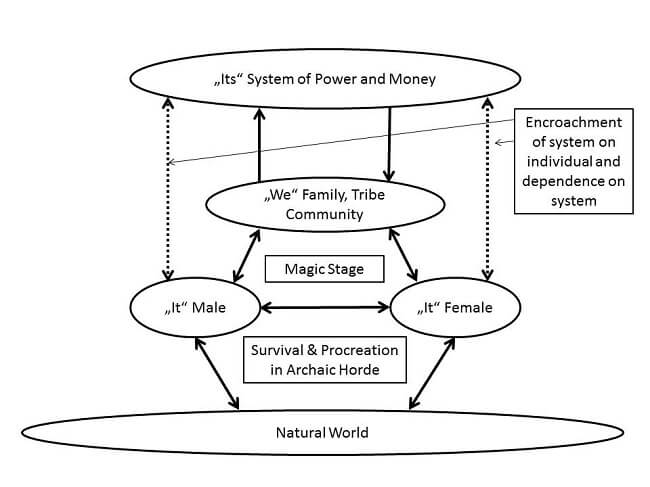
Model of the connection between individuals, families, communities and system
This equilibrium becomes out of balance when love relationships, families, and communities deteriorate because of liberal individualism; when individual freedoms become confronted with societal structures and order; and when the system—which is embedded in and depends on the lifeworld for its existence— encroaches upon, colonizes, displaces, and even destroys the lifeworld.
The resulting five “pathologies,” according to Habermas, are as follows :
- Decrease in shared meanings and mutual understandings.
- Erosion of social bonds (disintegration of communities.)
- Increase in people´s feelings of helplessness and lack of belonging.
- The consequent unwillingness of people to take responsibility for their actions and for social phenomena.
- Destabilization and breakdown of social order and stability.
5. They matter for the environment and people’s health
Population studies in Western countries show a growing number of singles living in single-person households, which accelerate consumption, deplete resources, and degrade nature. Recent studies show that living alone consumes more land, energy, goods, and materials per person than living in a community.[xi] and the same is likely true for travel, as couples share cars and rooms.
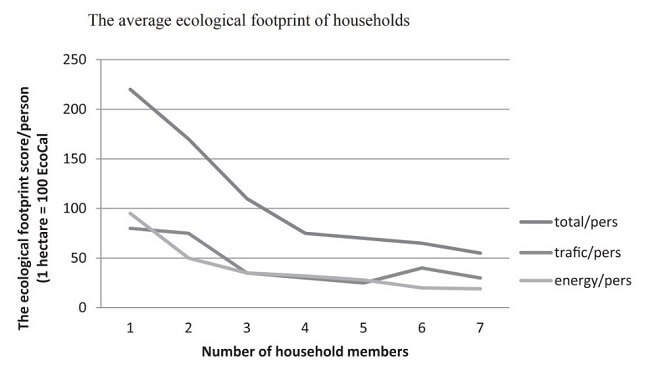
Ecological footprint of single versus family living
Couples are also less likely to smoke, drink, and to eat junk food.[xii] (It is unlcear what is cuase and effect, as college educated people are more likely to be married.) Thus, relationships matter for the environment and for our personal health.
6. They matter for sustainable populations and future generations
As we see in the images below, most countries now have, or are rapidly moving towards, fertility rates that are way below two children per woman; the exception for the next few decades is sub-Saharan Africa.

World fertility rate map here
See a country-by-country history and projection of fertility rates here (scroll down on that page and select the country you are interested in)
Over-aging and shrinking societies, as shown below, lead to increasing instability and bankruptcy of social systems, economic decline, loneliness, and possible defenselessness against invading nations with younger populations and/or fascist autocratic or dictatorial leaders.

Japan, China, and US[xv] populations age

German population age distribution 1910, 2005, and 2025
In her 2022 book, 8 Billion and Counting: How Sex, Death, and Migration Shape Our World, Jennifer D. Sciubba concludes that current population trends are unprecedented in human history and that no one really knows what the implications will be. Countries with many working-age adults and few children and elderly to care for may thrive economically during this demographic window, but will eventually fall into recessions as these workers retire and there are not enough children to replace them. These societies will also become vulnerable to attack by countries with younger and growing populations, or to destabilization caused by an influx of immigrants with different value systems.
See a six-minute 2016 video about population growth here.
The creators of this video did not consider levels of consciousness development and estimated overly high birth rates for Europe.
Thus, co-creation and procreation matter so that there are enough younger people to sustain the economies and stability of societies, fuel Social Security systems, care for older people, and, if necessary, defend their countries.
7. They matter for democracies and women’s rights:
In every region of the world, democracy is under attack by populist leaders and groups that reject pluralism and demand unchecked power to advance the particular interests of their supporters, usually at the expense of minorities and other perceived foes (including women).

Liberal and electoral democracies in decline
In electoral and closed autocracies, usually dominated by men, these perceived enemies often include liberated and empowered women (from Afghanistan to Iran and even the United States) who have expectations of partners that many men cannot meet and are fighting to turn back the tide. Changing this would require systemic change that supports boys and girls equally in their development, including the teaching of relationship skills in secondary and higher education.
8. They matter for cultural evolution
There is clear evidence that people at earlier levels of consciousness development procreate at much higher rates than people at later levels.[xviii] This now results in a backward shift of the societal center of gravity toward earlier stages of consciousness development in many modern and postmodern societies, as they fail to support the children who are born into families at earlier levels to advance to later stages of consciousness. The decline in fertility rates at higher levels of consciousness development may also explain the reversal of the Flynn Effect.[xix]
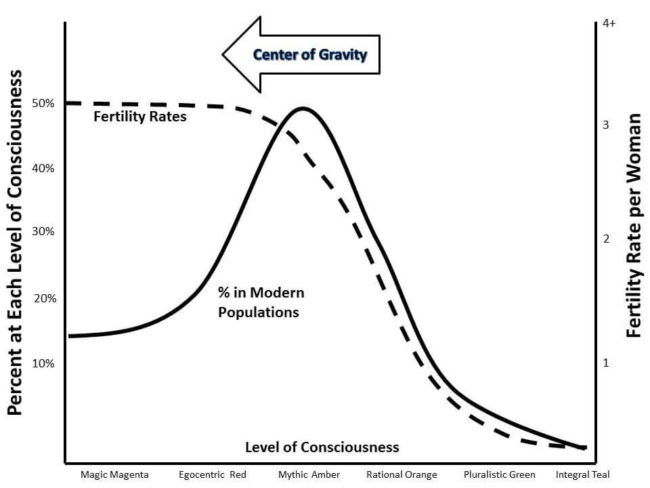
Fertility rates and overall decline in consciousness
Researchers in the United States and Germany have found a strong negative correlation between societal secularism and both national-level fertility rates and individual-level fertility behavior. Rather than religious people at mythic levels and below becoming a smaller proportion of the world’s population, demographers project that the religiously unaffiliated members of modern and postmodern societies will become a smaller proportion of the world’s population over time because they have fewer children.[xx]
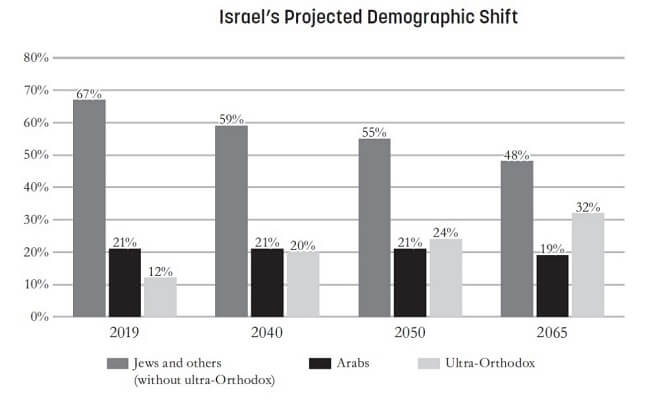
Israel’s projected demographic shift[xxi]
Thus, co-creation and procreation at later stages of consciousness development matter to shift the center of gravity beyond the limitations of the mythic, rational, and pluralistic stages towards a higher number of people at later stages of development.
9. They matter for communicative action
Traditionally, women had most rights and responsibilities in the domestic sphere, where they made feminine validity claims to care, compassion, relationships, and feelings about what is true, good, beautiful, and functional. Men had most rights and responsibilities in the public sphere, making masculine validity claims of rights, justice, autonomy, and rationality to guide and coordinate their actions in these four domains.

Female in domestic, and male in public sphere
As modern and postmodern women gain rights and responsibilities in the public sphere and men in the domestic sphere, it is essential that they both make feminine and masculine validity claims to coordinate their actions in both spheres.
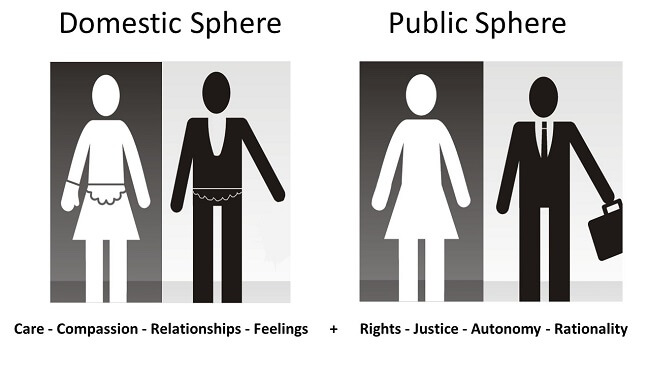
Female and male in the domestic and public spheres
Thus, Integral Relationships are important to move toward gender equality in rights and responsibilities through ethical discourse and communicative action in the domestic/private and public spheres.
10. They matter to counter social atomism
The misconception that human beings are isolated, separate, self-interested, autonomous, and largely self-sufficient individual “social atoms,” as proposed by modern liberalism, or products of cultural, social, or metaphysical (religious) “macro-systems,” as proposed by premodern conservatism, rather than simultaneously whole and partial “holarchic” relational beings, is at the root of the many private and public challenges facing humanity today.
To solve these wicked problems, we must collectively move toward valuing and supporting couples and families over individuals in ways that transcend the traditional conservative patriarchal family structures promoted by the conservative radical right, the modern hyper-individualism promoted by the liberal left, and the postmodern communalism promoted by the progressive radical left-and move toward holarchy. This requires an understanding of holonic structures and the practice of integral relationships.
Holons are wholes that are parts of larger wholes that have their own unique properties. They are the foundation of all functioning systems and societies. Balancing healthy feminine and masculine polarities is essential for individual holons (such as atoms, molecules, organs, and humans) and social holons (such as couples, families, communities, and societies) to maintain their simultaneous wholeness and partiality.
In the figure below, we see that stacking social holons on top of individual holons is philosophically problematic because social holons are only relatively dependent on the lower, while individual holons are completely dependent on the lower for their existence. For example, we can have communities without families, but not organs without cells.
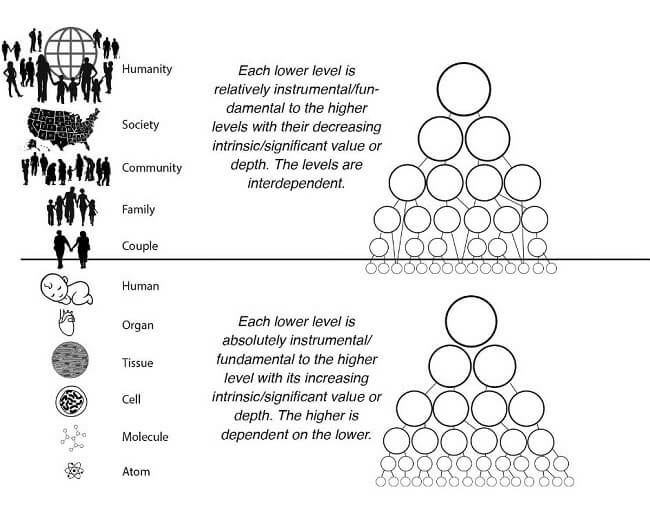
Figure 90: Individual and social holons
However, seen over time, functioning social holons also depend on the presence of the lower holons.[xxii] Denying this is the BIG fallacy.
The image below shows individual holons, from atoms to humans, and social holons, from couples to humanity, with their respective physical size, span (number), and depth, value, or love.

Size, depth, and span of individual and social holons
Until the advent of modernity, humans gave the greatest value, depth, or love to co-creating and procreating couples, rather than individuals, as shown above and below, because they were the foundation for the nuclear families necessary for communities to thrive and survive. We still see this today in all religious traditions, with their creeds of “preach and breed.”
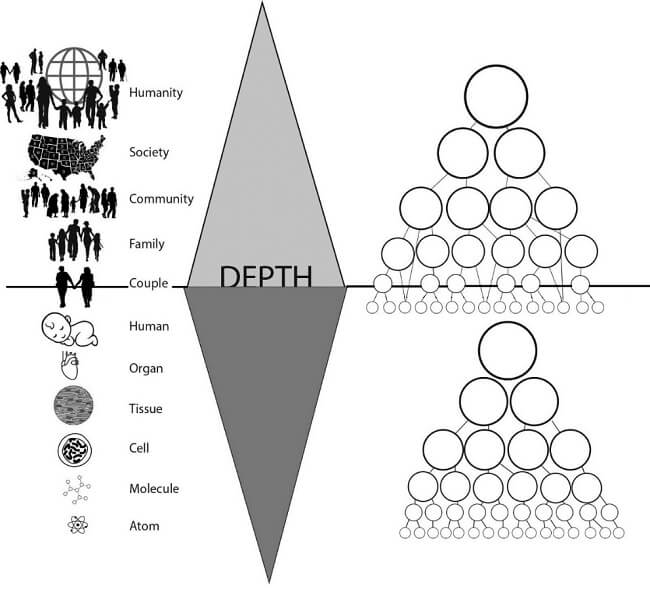
Holonic structure with highest depth given to couples
The image below shows the collapse of holonic structures in modern and postmodern societies that focus on the individual rather than the couple, family, and community.
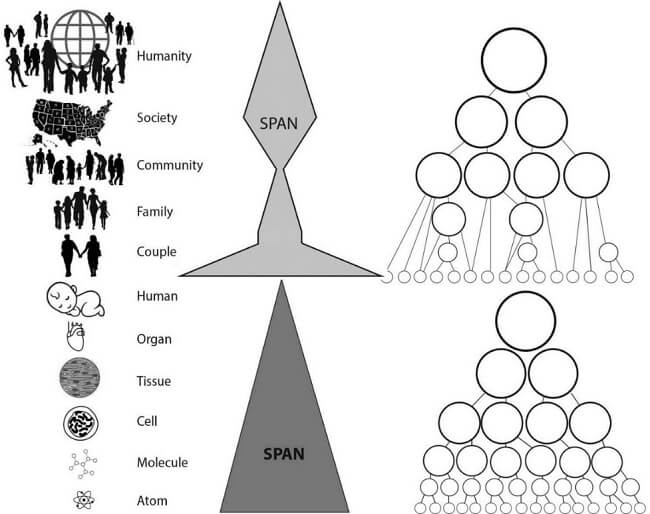
Collapsing social holons
Hence the importance of co-creation and procreation between couples in healthy Integral Relationships who form families and communities as the foundation for stable and sustainable societies and humanity.
Additional information and resources
The Couple: Intimate Relations in a New Key (2016) by Ferdinand Fellmann
www.amazon.com/Couple-Intimate-Relations-Development-Humanities/dp/3643907702/ about the primacy of the couple.
Habermas: A Very Short Introduction (2005) by Gordon Finlayson tinyurl.com/irpm552
www.amazon.com/Habermas-Short-Introduction-Gordon-Finlayson/dp/0192840959
A World after Liberalism: Philosophers of the Radical Right (2021) by Matthew Rose
www.amazon.com/World-after-Liberalism-Philosophers-Radical/dp/0300243111
Why Liberalism Failed (2019) by Patrick J. Deneen
www.amazon.com/Why-Liberalism-Failed-Politics-Culture/dp/0300240023/
8 Billion and Counting: How Sex, Death, and Migration Shape Our World (2022) by Jennifer D. Sciubba
www.amazon.com/Billion-Counting-Death-Migration-Shape/dp/1324002700
Dream Hoarders: How the American Upper Middle Class Is Leaving Everyone Else in the Dust, Why That Is a Problem, and What to Do about It (2017) by Richard Reeves
www.amazon.com/Dream-Hoarders-American-Leaving-Everyone/dp/081572912X
Endnotes Main Article
[1] In recent years, a vast scientific literature has emerged linking loneliness to depression, anxiety, alcoholism, and drug abuse. There is even a growing body of epidemiological work showing that loneliness makes you more likely to fall ill: it seems to prompt the chronic release of hormones that suppress healthy immune function. Biochemical changes from loneliness can accelerate the spread of cancer, hasten heart disease and Alzheimer’s, or simply drain the most vital among us of the will to go on. The ability to measure and detect it could help identify those at risk and pave the way for new kinds of interventions.
www.technologyreview.com/2020/09/04/1008008/neuroscience-loneliness-pandemic-covid-neurons-brain/
Lonely people also had significantly higher levels of norepinephrine coursing through their blood and shutting down immune functions like viral defense, while ramping up the production of white blood cells called monocytes.
www.npr.org/sections/health-shots/2015/11/29/457255876/loneliness-may-warp-our-genes-and-our-immune-systems
[ii] Studies found that people at higher income levels are more satisfied with life. Interestingly, even at annual income levels above $120,000, this positive correlation still applied. There is no saturation point, a higher income equals more happiness at all levels. These studies even showed that where incomes are increased by the same percentage, the impact is stronger at higher income levels than at lower income levels.
www.forbes.com/sites/rainerzitelmann/2020/07/06/does-money-make-people-happy/?sh=7b28d5b7574d
[iii] Researchers found that sex: (1) relieves stress, (2) boosts the immune system, (3) burns calories (85 or more in 30 minutes), (4) improves cardiovascular health, (5) boosts self-esteem, (6) improves intimacy, (7) reduces pain (through release of oxytocin), (8) reduces risk of prostate cancer, (9) strengthens pelvic floor muscles, and (10) helps you to sleep better. www.webmd.com/sex-relationships/guide/sex-and-health#1 and www.womenshealthnetwork.com/sexual-health/
Also see Patricia Love and Steven Stosny in How to Improve your Marriage Without Talking About It, page 148–150.
[iv] Until women began to enter the workforce, they were more often able to turn to nurturing and relaxing “tending and befriending” strategies with their partners, family, and friends when they felt stressed. These comforting activities triggered the release of the “cuddle hormone” oxytocin. Oxytocin naturally counters the harmful stress hormones cortisol and epinephrine, which increase blood pressure and blood sugar levels and weaken the immune system.
“In the modern environment one is exposed to various stressful conditions. Stress can lead to changes in the serum level of many hormones including glucocorticoids, catecholamines, growth hormone and prolactin. Some of these changes are necessary for the fight or flight response to protect oneself. Some of these stressful responses can lead to endocrine disorders like Graves’ disease, gonadal dysfunction, psychosexual dwarfism and obesity. Stress can also alter the clinical status of many preexisting endocrine disorders such as precipitation of adrenal crisis and thyroid storm.” www.ncbi.nlm.nih.gov/pmc/articles/PMC3079864/
Males, on the other hand, typically resorted to masculine fight-or-flight strategies to lower the stress hormones that arose for them in the public sphere and at home. Alas, fight-or-flight produces the stress-reducing hormones in much smaller amounts, and males got the short end of the stick, unless they received frequent care and sex from a loving and supportive partner at home. www.webmd.com/women/features/stress-women-men-cope#2
[v] A burgeoning literature suggests that marriage may have a wide range of benefits, including improvements in individuals’ economic well-being, mental and physical health, and the well-being of their children. https://aspe.hhs.gov/report/effects-marriage-health-synthesis-recent-research-evidence-research-brief
A major survey of 127,545 American adults found that married men are healthier than men who were never married or whose marriages ended in divorce or widowhood. Men who have marital partners also live longer than men without spouses; men who marry after age 25 get more protection than those who tie the knot at a younger age, and the longer a man stays married, the greater his survival advantage over his unmarried peers. www.health.harvard.edu/newsletter_article/marriage-and-mens-health
[vi] The origin of sexual reproduction can be traced to early prokaryotes, around two billion years ago (Gya), when bacteria began exchanging genes via conjugation, transformation, and transduction. https://en.wikipedia.org/wiki/Evolution_of_sexual_reproduction
[vii] Memetics is the study of information and culture based on an analogy with Darwinian evolution. Proponents describe memetics as an approach to evolutionary models of cultural information transfer. Memetics describes how an idea can propagate successfully, but doesn’t necessarily imply a concept is factual.
[viii] I asked Eckhart Tolle once why he wrote in The Power of Now: “Nothing matters, but everything is honored.” He went to great length to explain that we honor the creator (God) behind the creation without Ego desire or attachment to what is created. In my interpretation, he suggests that we transcend our ego to allow the co-creative and procreative impulse or life-force to manifest through our relational soul’s purpose to sustain the human race and create more goodness, truth, beauty, and functioning.
Adyashanti said after a couples retreat that he facilitated with his wife: “The depth and embodiment of your spiritual realization will be seen in your love relationships. That is where the proof is in the pudding. If it all collapses in your relationships, you have some work to do. And people have a lot of problems in their relationships.”
[ix] Also see Ezra Klein, May 2022 interview with Patrick Deneen www.nytimes.com/2022/05/13/podcasts/transcript-ezra-klein-interviews-patrick-deneen.html
[x] www.nytimes.com/2022/04/03/opinion/putin-ukraine-liberalism.html?smid=url-share
[xi] www.researchgate.net/publication/297048728_The_Environmental_Impact_of_Singles’_Consumer_Behaviour_Is_the_Lifestyle_of_Singles_Inevitably_Environmentally_More_Damaging
[xii] Research consistently shows that marriage and long-term relationships are good for your physical, mental, and financial health. www.theguardian.com/lifeandstyle/2016/apr/17/couples-healthier-wealthier-marriage-good-health-single-survey-research and www.ncbi.nlm.nih.gov/pmc/articles/PMC5830314/
[xv] www.cdc.gov/nchs/data/nvsr/nvsr70/nvsr70-17.pdf
[xvi] https://youtu.be/QsBT5EQt348
[xviii] See https://integralrelationship.com/ccpc with many graphics that is frequently updated.
[xix] In his telling 2017 book, Dream Hoarders: How the American Upper Middle Class Is Leaving Everyone Else in the Dust, Why That Is a Problem, and What to Do about It, Richard Reeves describes the separation of upper middle-class children from ordinary American kids. He looks at three forms of opportunity hoarding, in particular: exclusionary zoning, unfairness in college admissions, and the allocation of unpaid internships. www.amazon.com/Dream-Hoarders-American-Leaving-Everyone/dp/081572912X
Also see the 2019 BBC article, “Has Humanity Reached ‘Peak Intelligence’?” about the reversal of the Flynn effect which maintained that IQ test scores increase over time: “Whatever the cause of the Flynn effect, there is evidence that we may have already reached the end of this era—with the rise in IQs stalling and even reversing. If you look at Finland, Norway, and Denmark, for instance, the turning point appears to have occurred in the mid-90s, after which average IQs dropped by around 0.2 points a year. That would amount to a seven-point difference between generations. www.bbc.com/future/article/20190709-has-humanity-reached-peak-intelligence
[xx] A 2021 study proposes and explores a new fertility determinant: societal secularism. Using country-level data from multiple sources and multilevel data from 58 countries in the World Values Survey, the author documents a strong negative relationship between societal secularism and both country-level fertility rates and individual-level fertility behavior. Secularism, even in small amounts, is associated with population stagnation or even decline absent substantial immigration, whereas highly religious countries have higher fertility rates that promote population growth. This country-level pattern is driven by more than aggregate lower fertility of secular individuals. In fact, societal secularism is a better predictor of highly religious individuals’ fertility behavior than that of secular individuals, and this pattern is largely a function of cultural values related to gender, reproduction, and autonomy in secular societies. Beyond their importance for the religious composition of the world population, the patterns presented in the study are relevant to key fertility theories and could help account for below-replacement fertility.
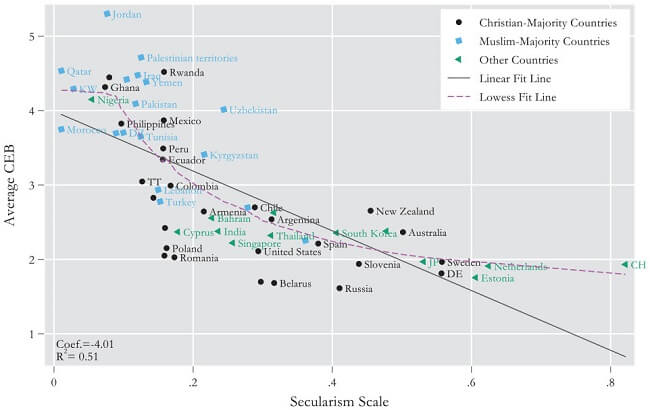
Secularism and decline in birth rates in various countries https://journals.sagepub.com/doi/full/10.1177/23780231211031320
See country by country history and projection of fertility rates at www.macrotrends.net/countries/USA/united-states/fertility-rate
Also see Dr. Michael Blume www.blume-religionswissenschaft.de/english/pdf/Biological_Success_of_Religion_Blume.pdf and his German book Religion und Demografie: Warum es ohne Glauben an Kindern mangelt (2014) by Dr. Michael Blume www.amazon.com/Religion-Demografie-Glauben-Kindern-mangelt/dp/1499110251
[xxi] From the 2022 book 8 Billion and Counting by Jennifer D. Sciubba https://www.amazon.com/Billion-Counting-Death-Migration-Shape/dp/1324002700
[xxii] Ken Wilber does not get tired to maintain that stacking social holons on top of individual holons, as shown below in this module, is problematic or a fallacy, because the social holarchy of couples, families, communities, societies, and humanity are not co-created (or emerge) in the same way as individual holons do, such as cells that form tissues, that form organs, that form humans.
His reasoning is threefold:
- Social holons have no single governing force, will, purpose, or “consciousness.”
- Social holons can exist even if we remove the smaller holons that they are created from. For example, a community can exist without families (at least for some time).
- Individual holons can more or less autonomously form, join, or leave social holons, while this freedom of movement is not available to holons that are parts of individual holons.
Epilogue
What Happened?
With the advent of modernity, and with it the rise of liberal democracy, feminism, freedom of speech, economic opportunity for all, globalism, and the influx of Eastern spirituality, most social theorists began to see societies as composed of a collection of separate, self-interested, autonomous, and largely self-sufficient individuals. This came to be known as social atomism.[i]
It is referenced in almost every modern socioeconomic and political discourse, and sometimes in spiritual teachings, which primarily address the individual and society. This is like saying that atoms make up our bodies and ignoring holarchies of molecules, cells, cell tissues, and organs. Likewise, on a social level, social atomism frequently ignores the importance of couples, families, and communities for social cohesion.
This is understandable, as modernity largely rejects traditional conservative, religiously motivated family values, which are often associated with anti-liberalism, patriarchy, oppression and objectification of women, pro-life movements, marginalization of minorities such as members of LGBTQ+ communities, racism, and, in some countries, white supremacy. This rejection of traditional family values by modernity, without having a model other than singlehood to replace it, now leads to increasing social isolation and instability.
Starting in the 1960s, postmodernity tried to address this issue of social fragmentation and isolation by promoting communal living and the practice of polyamory, along with the advocacy for civil rights, social justice, nonviolence, environmental protection, world peace, and care for all living things on our planet.
Alas, these progressive communities and movements frequently turned out to be fragmented and unstable, and thus, unsustainable, because they were not rooted in shared values that arose out of stable couple and family relationships with children, and because members could join and leave at will, with little commitment to the community. Furthermore, the decline in birth rates that had begun in late modernity and accelerated in postmodernity and post-postmodernity to almost zero children per woman resulted in insufficient numbers of offspring to fuel the progressive and New-Age movements, whose members also stifled upward mobility by rejecting hierarchies and, at the same time, creating segregated education systems.[ii] Consequently, for the first time in human history, cultural evolution became decoupled from biological evolution and, as a result—as we increasingly see today—liberal and socially progressive movements are struggling to advance.
On the other hand, we see that conservatives of the radical right who support autocratic leaders and often share traditional, religious, illiberal, nationalistic, and racist values increasingly out-procreate and out-vote left-leaning modern liberals and postmodern progressives of the radical left whose hopes for ongoing progress through cultural r/evolution become increasingly dwarfed.
The radicalization and widening chasm between the radical right and left holds the potential for new civil and international wars. This potential may be further fueled by the increasing number of frustrated males who can’t meet the primary fantasies and other expectations of modern and postmodern women who could have a moderating and stabilizing effect on them, but whose expectations these men can no longer meet.
Another negative effect of collapsing relationships and overall shrinking birth rates is the over-aging of societies, which produces more conservative voters and puts increasing strains on Social Security and healthcare systems that lay heavy financial burdens on younger, working generations and may soon become financially unsustainable.
The increasing number of singles has also a double negative effect on the environment. One effect is that they do not share resources like homes, appliances, utilities, vehicles, etc., in the way that couples and families do.[iv] The other is that single males who want to be in a relationship need to compete financially with other males and females to be able to acquire the status symbols such as expensive cars and homes, and to pay for dates and travel, etc., in order to be attractive to the women they desire.
Finally, if we look at the global picture, we see that the populations of modern societies are beginning to shrink and, by 2100, may be half their current size, while countries in sub-Saharan Africa are projected to triple or quadruple in population by 2100, to three or even four billion.[v] This means that the shrinking and over-aging populations of modern and postmodern societies with declining economies must either economically support these young and exploding populations to provide them with local opportunities and to slow down their rates of reproduction through education and empowerment of women, or deal with unprecedented levels of migration and possible military aggression that holds the potential for further national and international conflicts.
To address these major interconnected challenges of anti-democratic movements, climate change/environmental destruction, over/under population, migrations, and civil wars/military conflicts that humanity is potentially facing, we need to dramatically increase co-creation and procreation between soulmates at modern and postmodern levels of development in Integral Relationships.
With the advent of modernity, and with it the rise of liberal democracy, feminism, freedom of speech, economic opportunity for all, globalism, and the influx of Eastern spirituality, most social theorists began to see societies as composed of a collection of separate, self-interested, autonomous, and largely self-sufficient individuals. This became known as social atomism.[i]
It is referenced in almost every modern socio-economic and political discourse, and sometimes in spiritual teachings that are primarily concerned with the individual and society. This is like saying that atoms make up our bodies and ignoring the holarchies of molecules, cells, cell tissues, and organs. Similarly, at the social level, social atomism often ignores the importance of couples, families, and communities for social cohesion.
This is understandable because modernity largely rejects traditional, conservative, religiously motivated family values, which are often associated with anti-liberalism, patriarchy, the oppression and objectification of women, pro-life movements, the marginalization of minorities such as members of LGBTQ+ communities, racism, and, in some countries, white supremacy. Modernity’s rejection of traditional family values, with no model other than singlehood to replace it, is now leading to increasing social isolation and instability.
Beginning in the 1960s, postmodernism sought to address this problem of social fragmentation and isolation by promoting communal living and the practice of polyamory, along with advocacy for civil rights, social justice, nonviolence, environmentalism, world peace, and care for all living things on our planet.
Unfortunately, these progressive communities and movements often proved to be fragmented and unstable, and thus unsustainable, because they were not rooted in shared values derived from stable couple and family relationships with children, and because members could join and leave at will, with little commitment to the community. In addition, the decline in birth rates that began in late modernity and accelerated in postmodernity and post-postmodernity to almost zero children per woman resulted in an insufficient number of offspring to fuel progressive and New Age movements, whose members also stifled upward mobility by rejecting hierarchies while creating segregated educational systems.[ii] As a result, for the first time in human history, cultural evolution was decoupled from biological evolution, and as a result – as we increasingly see today – liberal and socially progressive movements are struggling to advance.
On the other hand, we see that conservatives of the radical right, who support autocratic leaders and often share traditional, religious, illiberal, nationalistic, and racist values, increasingly outnumber and outvote left-leaning modern liberals and postmodern progressives of the radical left, whose hopes for continued progress through cultural r/evolution are increasingly diminished.
The radicalization and widening gap between the radical right and the radical left holds the potential for new civil and international wars. This potential may be further fueled by the increasing number of frustrated men who can’t meet the primary fantasies and other expectations of modern and postmodern women who could have a moderating and stabilizing effect on them, but whose expectations these men can no longer meet.
Another negative effect of the breakdown of relationships and the general decline in birth rates is the aging of societies, which produces more conservative voters and puts increasing strain on social security and health care systems, which place a heavy financial burden on younger working generations and may soon become financially unsustainable.
The growing number of singles also has a double negative effect on the environment. One effect is that they do not share resources such as homes, appliances, utilities, vehicles, etc. in the way that couples and families do.[iv] The other effect is that single men who want to be in a relationship must compete financially with other men and women to acquire the status symbols such as expensive cars and homes, and to pay for dates, travel, etc. in order to be attractive to the women they desire.
Finally, if we look at the global picture, we see that the populations of modern societies are beginning to shrink and may be half their current size by 2100, while the countries of sub-Saharan Africa are projected to triple or quadruple in population to three or even four billion by 2100.[v] This means that the shrinking and aging populations of modern and postmodern societies with declining economies will either have to economically support these young and exploding populations to provide them with local opportunities and slow their reproduction rates through education and empowerment of women, or deal with unprecedented levels of migration and possible military aggression, which will have the potential to create a new world order.
To address these major interrelated challenges of anti-democratic movements, climate change/environmental degradation, overpopulation/underpopulation, migrations, and civil wars/military conflicts potentially facing humanity, we need to dramatically increase co-creation and procreation between soulmates at modern and postmodern levels of development in integral relationships.
Endnotes Epilogue
[i] According to the philosopher Charles Taylor, the term “atomism” is used loosely to characterize the doctrines of social contract theory which arose in the seventeenth century and also successor doctrines which may not have made use of the concept of social contract, but which inherited a vision of society as in some sense constituted by individuals for the fulfilment of ends which were primarily individual. Certain forms of utilitarianism are successor doctrines in this sense. The term is also applied to contemporary doctrines which harken back to social contract theory, or which try to defend in some sense the priority of the individual and his rights over society, or which present a purely instrumental view of society. https://en.wikipedia.org/wiki/Atomism_(social)
[ii] See the book Dream Hoarders: How the American Upper Middle Class Is Leaving Everyone Else in the Dust, Why That Is a Problem, and What to Do About It (revised edition 2018) by Richard V. Reeves
The separation of the upper middle class from everyone else is both economic and social, and the practice of “opportunity hoarding”—gaining exclusive access to scarce resources—is especially prevalent among parents who want to perpetuate privilege to the benefit of their children.
www.amazon.com/Dream-Hoarders-American-Leaving-Everyone/dp/0815734484
[iv] Think about your household’s monthly expenses. There are the big-ticket items—your rent or mortgage, your health care, maybe a student loan. Then there’s the smaller stuff: the utility bills; the internet and phone bills; Netflix, Hulu, and all your other streaming subscriptions. If you drive a car, there’s gas and insurance. If you take the subway, there’s a public transit pass. You pay for food, and household items like toilet paper and garbage bags and lightbulbs. You buy furniture and sheets and dishes. Now imagine paying for all those things completely on your own. If you live by yourself—or as a single parent or caregiver—you don’t have to imagine. This is your life.
www.vox.com/the-goods/22788620/single-living-alone-cost
[v] www.populationpyramid.net/sub-saharan-africa/2100/
www.thelancet.com/pdfs/journals/lancet/PIIS0140-6736(20)31522-1.pdf



